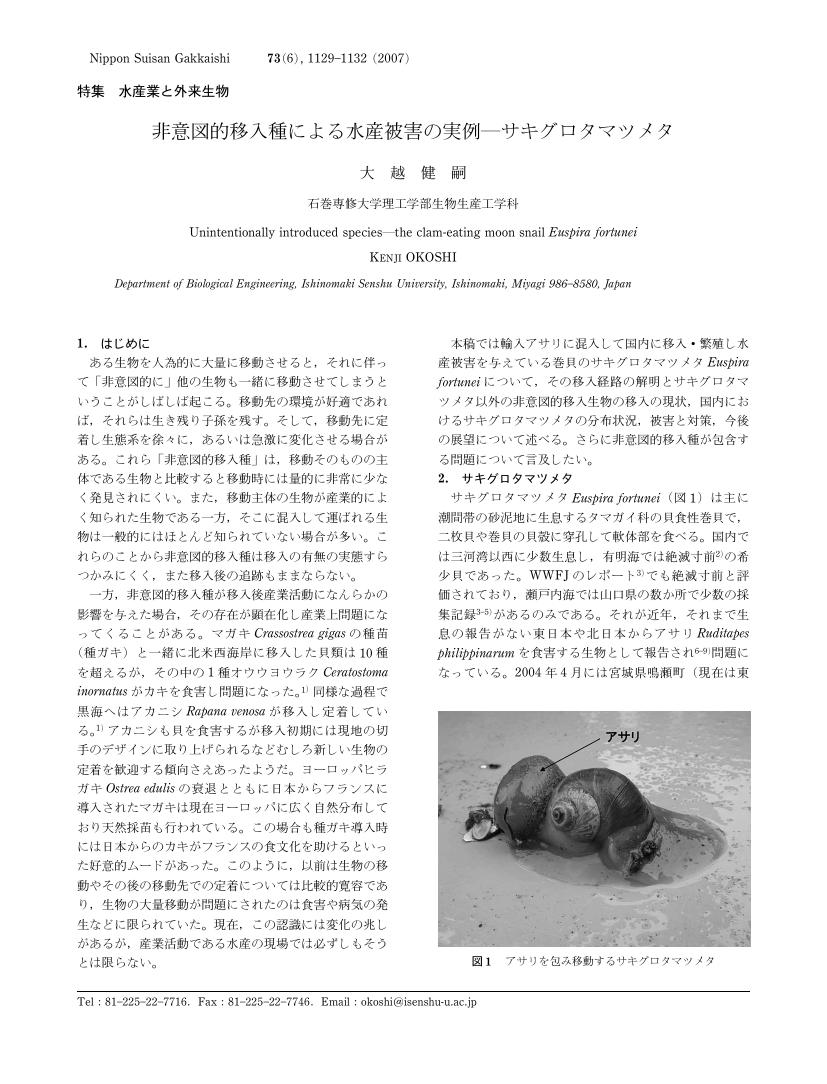- 著者
- 岩崎 敬二 木村 妙子 木下 今日子 山口 寿之 西川 輝昭 西 栄二郎 山西 良平 林 育夫 大越 健嗣 小菅 丈治 鈴木 孝男 逸見 泰久 風呂田 利夫 向井 宏
- 出版者
- JAPANESE ASSOCIATION OF BENTHOLOGY
- 雑誌
- 日本ベントス学会誌 = Japanese journal of benthology (ISSN:1345112X)
- 巻号頁・発行日
- vol.59, pp.22-44, 2004-07-28
- 被引用文献数
- 24 26
To investigate the invasion history and recent geographic distribution of marine organisms introduced to Japan or transferred domestically to non-native regions, a questionnaire survey on their occurrence in the field, including both published and unpublished records, was conducted in 2002-2003. A total of 105 taxa was reported by 94 respondents. According to three criteria, viz. known or unknown geographic origin, established invasion history, and presumed dispersal mechanisms associated with human activities, 42 taxa were designated as non-indigenous species introduced to Japan through human activities, 26 taxa as indigenous species that are distributed both in Japan and other countries but are introduced from abroad to Japan for fisheries or as fish bait, 20 taxa as cryptogenic species which are not demonstrably native or introduced, two taxa as non-indigenous species that have extended their range to Japan through natural dispersion, and one taxon as an indigenous species. The remaining 14 taxa were considered to have been transferred domestically to new areas. Analysis of the years of first record of 42 non-indigenous species suggests that the rate of invasion has increased over the past century, with seven or eight species being introduced per decade after 1960. Data on temporal change in geographic distribution revealed that many non-indigenous species have become widespread recently, from the Pacific coasts of central Japan to the coasts of the Sea of Japan or northward. However, the species listed in the present study are not exhaustive, and more extensive investigations covering all taxa and all presumed dispersal mechanisms are urgently needed before consideration of legislative management of introduced marine organisms.
2 0 0 0 OA 震度6の地震…その時,大学では何が起こったか(支部のページ)
- 著者
- 大越 健嗣
- 出版者
- 公益社団法人日本水産学会
- 雑誌
- 日本水産学会誌 (ISSN:00215392)
- 巻号頁・発行日
- vol.69, no.6, pp.988-990, 2003-11-15
2 0 0 0 OA シロウリガイ類飼育の試み
- 著者
- 三宅 裕志 山本 啓之 北田 貢 植田 育男 大越 健嗣 喜多村 稔 松山 和世 土田 真二
- 出版者
- 日本海洋学会
- 雑誌
- 海の研究 (ISSN:09168362)
- 巻号頁・発行日
- vol.14, no.6, pp.645-651, 2005-11-05
- 被引用文献数
- 1 4
シロウリガイ類は深海から採集すると通常2, 3日しか生存せず, 飼育を試みた報告は皆無であった。本研究では, シロウリガイ類の飼育の試みとして, 良好な健康状態で採集し, かつシロウリガイ類の共生細菌のエネルギー源(泥中の硫化水素)を確保するために, 圧力以外の現場環境をできる限り維持した状態で採集する装置のMTコアを開発した。また, シロウリガイ類は高酸素濃度に弱いため, 溶存酸素濃度制御装置により低酸素濃度環境を維持する飼育システムを製作した。シロウリガイとエンセイシロウリガイをそれぞれ相模湾初島沖水深1,150m〜1,160mの地点, 石垣島沖の黒島海丘の643mの地点で採集した。採集したシロウリガイは約1週間で死亡したが, 黒島海丘のエンセイシロウリガイは17日間生存した。また, エンセイシロウリガイでは2回放卵が確認された。以上のことから, エンセイシロウリガイは飼育が容易な種と考えられた。
1 0 0 0 OA 輸入アサリに混入して移入する生物―食害生物サキグロタマツメタと非意図的移入種
- 著者
- 大越 健嗣
- 出版者
- 日本ベントス学会
- 雑誌
- 日本ベントス学会誌 (ISSN:1345112X)
- 巻号頁・発行日
- vol.59, pp.74-82, 2004-07-28 (Released:2010-02-05)
- 参考文献数
- 30
- 被引用文献数
- 30 30
The clam Ruditapes philippinarum is a commercially important fishery resource in Japan. Because the amount of production has been decreasing gradually in Japan, the clam has been imported from China and Korea in recent years to provide seed for aquaculture and also for recreational shellfish gathering. The object of this study is to confirm whether alien species are being introduced together with the clam and to obtain information on their distribution in Japanese waters. Three species of mollusk-eating moon snail, Euspira fortunei, Glossaulax didyma, and Glossaulax reiniana, were collected from sacks filled with R. philippinarum imported from China. Seven other gastropod species, nine species of bivalves including Meretrix pethechialis, the purse crab Phiiyra pisum, and a brachiopod, Lingula unguis, were also collected from the sacks. Almost all the unintentionally introduced animals were living and were directly released with commercially introduced clams into Mangoku-ura Inlet, Miyagi Prefecture, by a fishermen's cooperative. Although the snail Euspira fortunei is not indigenous to the eastern and northern coasts of Japan, relatively large populations of it occur in the clam production areas of Lake Hamana (Shizuoka), the estuary of the Obitsu River (Chiba), and Mangoku-ura Inlet. I believe that a population of this invasive snail has already been established at least in Mangoku-ura Inlet and is becoming a new, strong predator of the clam stocks. Prevention of further spread and estimation of the rate of predation are important to the clam culture. Among the 22 alien species recorded in this survey, seven were also found in the native communities. The effect of the alien population on the preexisting population is also important problem to be solved.
1 0 0 0 外来巻貝サキグロタマツメタのアサリに対する捕食
- 著者
- 大越 健嗣
- 出版者
- 公益社団法人 日本水産学会
- 雑誌
- 日本水産學會誌 = Bulletin of the Japanese Society of Scientific Fisheries (ISSN:00215392)
- 巻号頁・発行日
- vol.78, no.5, pp.979-982, 2012-09-15
- 参考文献数
- 11
- 被引用文献数
- 1
1 0 0 0 OA 非意図的移入種による水産被害の実例—サキグロタマツメタ
- 著者
- 大越 健嗣
- 出版者
- 公益社団法人 日本水産学会
- 雑誌
- 日本水産学会誌 (ISSN:00215392)
- 巻号頁・発行日
- vol.73, no.6, pp.1129-1132, 2007 (Released:2007-11-26)
- 参考文献数
- 9
- 被引用文献数
- 10 10
1 0 0 0 OA 現世および化石カキ礁の形成過程から解明する古環境とカキ類の古生態変遷
1 0 0 0 シロウリガイ類飼育の試み
- 著者
- 三宅 裕志 山本 啓之 北田 貢 植田 育男 大越 健嗣 喜多村 稔 松山 和世 土田 真二 Hiroshi Miyake Hiroyuki Yamamoto Mitsugu Kitada Ikuo Ueda Kenji Okoshi Minoru Kitamura Kazuyo Matsuyama Shinji Tsuchida 新江ノ島水族館:海洋研究開発機構(JAMSTEC) 新江ノ島水族館 新江ノ島水族館 新江ノ島水族館 石巻専修大学 海洋研究開発機構(JAMSTEC) 海洋研究開発機構(JAMSTEC) 海洋研究開発機構(JAMSTEC) Enoshima Aquarium:Japan Agency for Marine-Earth Science and Technology Center (JAMSTEC) Enoshima Aquarium Enoshima Aquarium Enoshima Aquarium Ishinomaki Senshu University Japan Agency for Marine-Earth Science and Technology Center (JAMSTEC) Japan Agency for Marine-Earth Science and Technology Center (JAMSTEC) Japan Agency for Marine-Earth Science and Technology Center (JAMSTEC)
- 出版者
- 日本海洋学会
- 雑誌
- 海の研究 (ISSN:09168362)
- 巻号頁・発行日
- vol.14, no.6, pp.645-651, 2005-11-05
- 参考文献数
- 9
- 被引用文献数
- 1 4
シロウリガイ類は深海から採集すると通常2, 3日しか生存せず, 飼育を試みた報告は皆無であった。本研究では, シロウリガイ類の飼育の試みとして, 良好な健康状態で採集し, かつシロウリガイ類の共生細菌のエネルギー源(泥中の硫化水素)を確保するために, 圧力以外の現場環境をできる限り維持した状態で採集する装置のMTコアを開発した。また, シロウリガイ類は高酸素濃度に弱いため, 溶存酸素濃度制御装置により低酸素濃度環境を維持する飼育システムを製作した。シロウリガイとエンセイシロウリガイをそれぞれ相模湾初島沖水深1,150m~1,160mの地点, 石垣島沖の黒島海丘の643mの地点で採集した。採集したシロウリガイは約1週間で死亡したが, 黒島海丘のエンセイシロウリガイは17日間生存した。また, エンセイシロウリガイでは2回放卵が確認された。以上のことから, エンセイシロウリガイは飼育が容易な種と考えられた。


